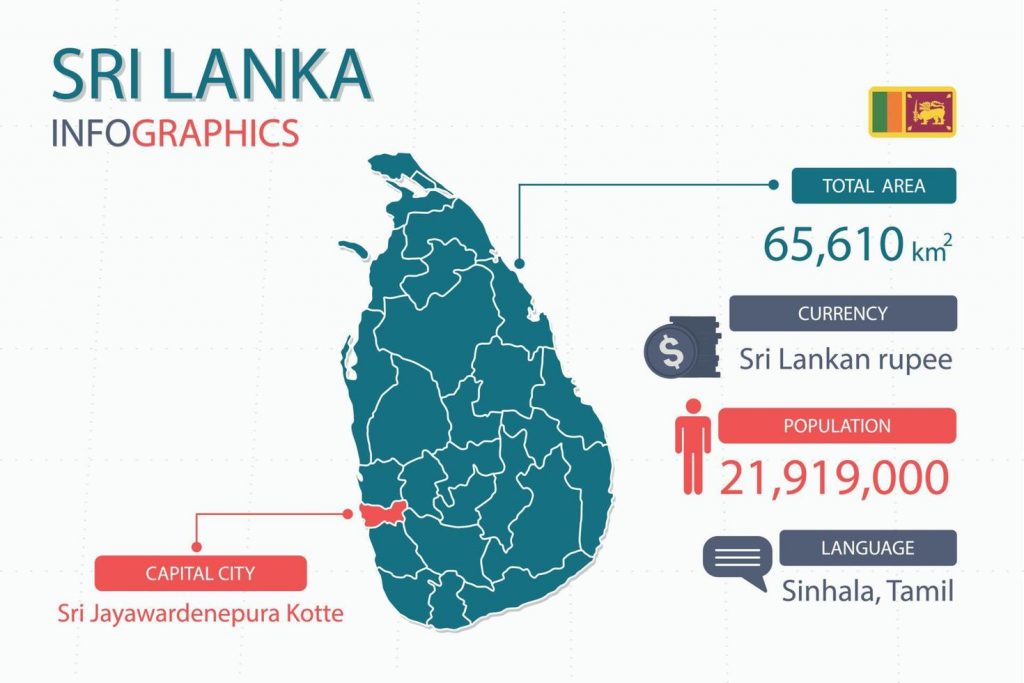The origins of the Sinhalese Language
Sinhalese, or Sinhala as it’s referred to locally, is the official language in Sri Lanka and mostly associated with the Sinhalese people, the largest ethnic group in the country. There are about 14 million speakers with an additional 2 million who claim it as a second language. Sinhala has historical importance due to its role in the development of works and texts in Theravada Buddhism.
Sinhala is categorized as an Indo-Aryan language. Languages that are related to it include Maldivian, Hindi, and Urdu. Special characteristics of Sinhala include its diglossic nature. That is, the written language and spoken language differ quite a bit in terms of grammar, vocabulary, and more. The written language is considered the more formal version, being used in large formal events, public media, news, etc. The spoken language is the vernacular being used in everyday affairs. This diglossia is quite profound, where some linguists have compared learning the written language as a member of the speech community akin to learning a foreign language.
Sinhala is a language with five cases. The word order is subject-object-verb. Interestingly and unlike many other world languages, Sinhala does not have a copula. In English, this would be the verb to be. In addition, Sinhala is categorized as a pro-drop language, where only the essential elements of a sentence is needed to be considered grammatically correct, as long as other elements can be inferred.
Sinhala has been influenced by a number of languages throughout its existence, mainly due to the colonial rule of Sri Lanka by certain empires. Thus, modern Sinhala contains loanwords that have roots in Portuguese, English, and Dutch. Other influences include Tamil, which has influenced its vocabulary, phonology, and grammar. However, Sinhala, as a language with ancient roots, has also influenced many other languages as well. A notable case is with Macanese Patois, a creole that exists in Macau. It is a mix of Sinhala, Cantonese, Portuguese, and Malay.
Sinhala is written using its own alphabet, the Sinhalese alphabet, which is based on the Brahmi script. Historically, it is closely related to South Indian Grantha alphabet as well as the Khmer alphabet. Like these alphabets, it is categorized as an abugida, a writing system where consonants play a prominent role, and vowel symbols modify consonants to change their natural sound. The Sinhalese alphabet consists of 60 main letters in total, with 42 consonants and 18 vowels. However, not all of them are used. Sinhala is written from left-to-right.

Sinhala’s ancestral language is Elu, which ultimately stems from Prakrit. It is considered the ancient form of Sinhala. This form of the language existed until about 200 AD. From the 3rd to 7th centuries, the language was known as Proto-Sinhalese. This version is basically a group of dialects that would solidify into the Sinhala we know today. The solidification furthered in the stage of Medieval Sinhalese from the 7th to 12th centuries. Modern Sinhalese is considered by linguists to have begun in the 12th century.
Sinhala has been said to be brought to Sri Lanka by the Sinhalese people from India around the 6th century BCE. Because of this separation of the language from its sibling languages, the language evolved in a different way. It is heavily influenced by Pail and Sanskrit. Throughout its development, a number of linguistic changes have happened, but not many are well documented. Most linguists agree though that Sanskrit had a large influence on Sinhala in its early development. Most of the changes that have been documented have to do with the phonology and pronunciation of the languages. Sources that do document the language in not such a linguistic manner include the Mahavasa, an epic poem written in Pail, another ancient language. There are a number of Buddhist texts though that are considered to be in the Sinhalese Prakrit language, the first iteration of the language, at the time when Buddhism first arrived in Sri Lanka. A number of folk tales and children’s stories also exist. In addition, the oldest Sinhala grammar was written in the 13th century which identified native Sinhala words, as opposed to Sanskrit words or vocabulary from other language sources. Thus, in a certain way, Sinhala can be said to have a long literary tradition. However, scholarly work on its development is limited compared to other world languages.
Currently, Sinhala manifests itself in many dialect forms. In Sri Lanka, it is spoken in the Southern Province, and this constitutes one dialect group. The Central Provinces and the North-Central Provinces also constitute two dialect groups. However, all the dialects are mutually intelligible.
In current times, there are also a number of Sinhala writers who write in the language about current Sri Lankan life. As there is a film industry as well as a theatre industry, the language plays an important part in the culture in the country as well as in other communities outside the country that identify with the language. In addition, with its history as a religious language, and with Buddhism being closely tied to education, Sinhala has played an important role in both literacy and pedagogy in the country. Other groups outside of Asia also speak the language, including Sinhalese people who have emigrated to other countries for various reasons. Countries that have a sizeable Sri Lankan population include the United States, the United Kingdom, Canada, and Australia.
VEQTA can provide you with a perfect Sinhalese translator for your Sinhalese translation, English to Sinhalese translation and Sinhalese to english translation for the your targeted locale. Our translations to Sinhalese are created with your target audience in mind to meet your expectations.
If you need to translate Sinhalese – Get in touch today!
A dedicated team of Sinhalese translators who combines Experience, Specialized Subject Matter Expertise with Translation Practices to deliver quality second to none.
Sinhalese Subject Expertise
Sinhalese Translators
Sinhalese Editors
Sinhalese Copywriters
Sinhalese Reviewers
Sinhalese Voice dubbing
Sinhalese Subtitling
Sinhalese Transcription


